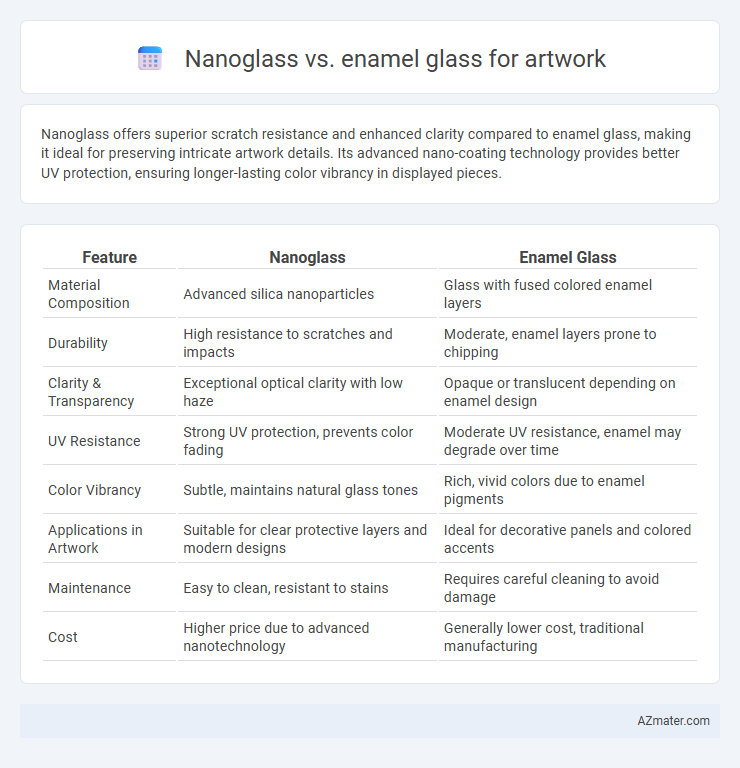Nanoglass offers superior scratch resistance and enhanced clarity compared to enamel glass, making it ideal for preserving intricate artwork details. Its advanced nano-coating technology provides better UV protection, ensuring longer-lasting color vibrancy in displayed pieces.
Table of Comparison
| Feature | Nanoglass | Enamel Glass |
|---|---|---|
| Material Composition | Advanced silica nanoparticles | Glass with fused colored enamel layers |
| Durability | High resistance to scratches and impacts | Moderate, enamel layers prone to chipping |
| Clarity & Transparency | Exceptional optical clarity with low haze | Opaque or translucent depending on enamel design |
| UV Resistance | Strong UV protection, prevents color fading | Moderate UV resistance, enamel may degrade over time |
| Color Vibrancy | Subtle, maintains natural glass tones | Rich, vivid colors due to enamel pigments |
| Applications in Artwork | Suitable for clear protective layers and modern designs | Ideal for decorative panels and colored accents |
| Maintenance | Easy to clean, resistant to stains | Requires careful cleaning to avoid damage |
| Cost | Higher price due to advanced nanotechnology | Generally lower cost, traditional manufacturing |
Introduction to Nanoglass and Enamel Glass
Nanoglass features a nanoscale surface coating that enhances durability and scratch resistance, making it ideal for protecting and preserving delicate artwork. Enamel glass, traditionally created by fusing powdered glass to a substrate through high heat, offers vibrant color retention and a glossy, smooth finish prized in decorative art pieces. Both materials provide unique protective and aesthetic properties, with nanoglass excelling in strength and transparency while enamel glass delivers rich pigmentation and texture.
Material Composition and Manufacturing Process
Nanoglass for artwork incorporates nanoparticles embedded within a silica matrix, enhancing mechanical strength and optical clarity compared to traditional enamel glass, which consists of powdered glass fused onto a metal substrate through high-temperature firing. Nanoglass manufacturing involves sol-gel techniques and controlled nanoparticle dispersion to create a uniform, durable surface, whereas enamel glass relies on melting and cooling cycles to bond the vitreous coating. The advanced nanocomposite material composition of nanoglass enables superior scratch resistance and longevity, making it ideal for preserving vibrant artwork details.
Aesthetic Qualities and Visual Appeal
Nanoglass offers superior clarity and enhanced light transmission compared to traditional enamel glass, creating a more vibrant and detailed presentation of artwork. Its smooth, ultra-clear surface provides a modern, sleek aesthetic that enhances color depth and contrast without distortion. Enamel glass, meanwhile, delivers a rich, textured finish with the potential for artistic customization but may reduce the sharpness and brilliance of underlying images.
Durability and Longevity in Artwork
Nanoglass exhibits superior durability and scratch resistance compared to traditional enamel glass, making it ideal for preserving artwork over time. Its advanced nanoscale coating enhances longevity by protecting against UV radiation, fading, and chemical degradation. Enamel glass, while vibrant and decorative, is more prone to chipping and color deterioration, limiting its effective lifespan in artwork preservation.
Resistance to Stains, Scratches, and Chemicals
Nanoglass exhibits superior resistance to stains, scratches, and chemicals compared to traditional enamel glass, making it ideal for protecting delicate artwork surfaces. Its advanced nanotechnology creates a highly durable, non-porous layer that prevents discoloration and surface damage from exposure to oils, solvents, and everyday contaminants. Enamel glass offers good aesthetic qualities but is more prone to scratches and chemical etching, which can compromise the integrity and visual clarity of the artwork over time.
Customization and Artistic Flexibility
Nanoglass offers superior customization and artistic flexibility compared to enamel glass, enabling artists to achieve intricate details and vibrant color variations with advanced nanoparticle technology. Its transparency and scratch resistance allow for durable, high-resolution artwork on various surfaces without compromising visual clarity. Enamel glass, while traditional and rich in texture, lacks the same level of precision and long-term durability, making nanoglass ideal for contemporary, customizable art installations.
Cost Comparison: Nanoglass vs Enamel Glass
Nanoglass often has a higher initial cost compared to enamel glass due to advanced manufacturing technologies and superior durability. Enamel glass remains more affordable for large-scale or budget-conscious art projects but may require more frequent maintenance and replacement. Evaluating long-term expenses shows nanoglass can offer cost savings through its enhanced scratch resistance and color retention, reducing restoration frequency.
Applications in Contemporary and Traditional Art
Nanoglass offers superior clarity and scratch resistance, making it ideal for protecting delicate contemporary artwork while maintaining vibrant color accuracy. Enamel glass, favored in traditional art, provides rich, opaque surfaces perfect for detailed painting and stained glass techniques. Both materials enhance durability, but nanoglass is preferred for modern galleries prioritizing minimal distortion and long-term preservation.
Environmental Impact and Sustainability
Nanoglass offers superior environmental benefits compared to traditional enamel glass due to its energy-efficient manufacturing process that reduces carbon emissions by up to 30%. Its enhanced durability and scratch resistance extend the lifespan of artwork, minimizing waste and the need for frequent replacements. Enamel glass, while visually vibrant, typically involves higher-temperature production and the use of hazardous materials, contributing to a larger ecological footprint.
Choosing the Right Glass for Your Artwork
Selecting the right glass for artwork preservation involves understanding the benefits of Nanoglass and Enamel glass. Nanoglass offers superior anti-reflective properties and enhanced UV protection, making it ideal for safeguarding colors and details in valuable paintings or prints. Enamel glass, known for its durability and vibrant clarity, provides excellent scratch resistance while maintaining a glossy finish that enhances the visual impact of framed artwork.

Infographic: Nanoglass vs Enamel glass for Artwork
 azmater.com
azmater.com